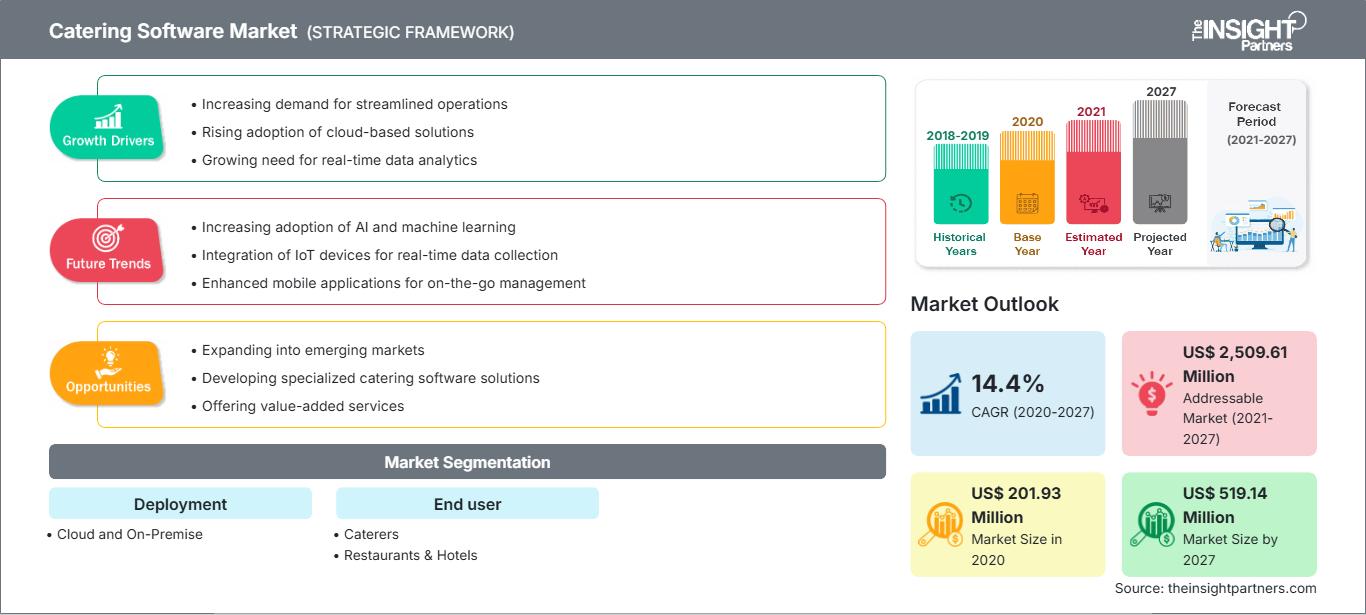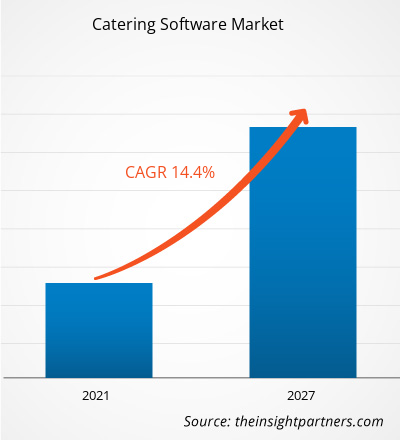预计餐饮软件市场规模将从 2020 年的 2.0193 亿美元增长到 2027 年的 5.1914 亿美元;预计 2020 年至 2027 年的复合年增长率为 14.4%。
大数据分析技术用于改善餐饮运营,推动了市场的增长。大数据分析技术具有彻底改变餐饮业的巨大潜力。采用大数据解决方案有助于提高整个餐饮行业分销和生产网络的效率。该技术可以跟踪物资运输的整个过程。凭借实时洞察,客户可以在自己的设备上跟踪采购订单并查看餐饮状态。餐饮软件中分析仪表板的集成有助于跟踪和评估餐饮代理商的绩效。此外,餐饮业的每个利益相关者都必须拥有其产品的相关数据,包括与农民、托运人和零售商相关的数据,以及餐馆和商店的数据。例如,肯德基餐厅使用大数据工具分析顾客反馈和食物偏好,从而提升顾客体验、销售额和利润。
过去几年,各地区的电子商务行业都经历了诸多变革;该行业的增长促使餐饮软件市场参与者利用大数据分析来做出更明智的商业决策。这项技术使在线零售商能够评估移动设备、社交媒体和网站等渠道的客户互动。
自定义此报告以满足您的要求
您将免费获得任何报告的定制,包括本报告的部分内容,或国家级分析、Excel 数据包,以及为初创企业和大学提供超值优惠和折扣
餐饮软件市场: 战略洞察

- 获取本报告的主要市场趋势。这个免费样本将包括数据分析,从市场趋势到估计和预测。
您将免费获得任何报告的定制,包括本报告的部分内容,或国家级分析、Excel 数据包,以及为初创企业和大学提供超值优惠和折扣
餐饮软件市场: 战略洞察

- 获取本报告的主要市场趋势。这个免费样本将包括数据分析,从市场趋势到估计和预测。
随着 COVID-19 疫情在全球爆发,由于世界各国政府发布的各种遏制措施,一些企业被迫缩减运营规模。病毒的迅速传播促使世界各国政府对人员和车辆的流动实施了严格的限制。依靠实体互动创造收入的企业受到了封锁的严重打击。因此,一些企业正专注于通过数字媒体来提高转化率、互动量和收入。
市场洞察 — 餐饮软件市场 机器学习将彻底改变餐饮业
在餐饮行业,区域地图绘制的不足以及需求和资源可用性之间的不平衡带来了诸多挑战。机器学习和人工智能 (AI) 是下一代餐饮技术的基础。这些技术使系统能够从记录的数据中学习,这些数据包括算法、模式和预测见解。许多在线食品配送公司正在采用机器学习技术来增强其餐饮业务并提高业务效率。例如,总部位于英国的食品配送公司 Deliveroo 投资机器学习等先进技术,通过提供更高效的食品配送服务来保持市场竞争力。总部位于西班牙的食品配送公司 Glovo 也使用机器学习来预测用户在其应用上保持活跃的概率。因此,预计机器学习与餐饮业务的整合将在预测期内推动餐饮软件的需求。
基于部署的洞察
根据部署类型,餐饮软件市场分为云端和本地部署。云端部分在 2019 年占据了最大的市场份额。
餐饮软件市场
The Insight Partners 的分析师已详尽阐述了预测期内餐饮软件市场的区域趋势和影响因素。本节还讨论了北美、欧洲、亚太地区、中东和非洲以及南美和中美洲的餐饮软件市场细分和地域分布。
餐饮软件市场报告范围
| 报告属性 | 细节 |
|---|---|
| 市场规模 2020 | US$ 201.93 Million |
| 市场规模 2027 | US$ 519.14 Million |
| 全球复合年增长率 (2020 - 2027) | 14.4% |
| 历史数据 | 2018-2019 |
| 预测期 | 2021-2027 |
| 涵盖的领域 |
By 部署
|
| 覆盖地区和国家 | 北美
|
| 市场领导者和主要公司简介 |
|
餐饮软件市场参与者密度:了解其对业务动态的影响
餐饮软件市场正在快速增长,这得益于终端用户需求的不断增长,而这些需求的驱动因素包括消费者偏好的不断变化、技术进步以及对产品优势的认知度不断提高。随着需求的增长,企业正在扩展其产品线,不断创新以满足消费者需求,并抓住新兴趋势,从而进一步推动市场增长。

- 获取 餐饮软件市场 主要参与者概述
餐饮软件市场的参与者主要致力于开发先进高效的产品。
- 2020 年,CaterZen 自 3 月初以来投入了大量编程时间,以确保餐厅和餐饮服务商能够通过重点关注在线订餐和外卖来继续运营。
- 2020 年,Flex Catering 推出了餐饮 KDS(厨房显示系统),这是一种数字屏幕,可取代餐厅和食品企业中的印刷或手写订单票。
餐饮软件市场细分如下:全球餐饮软件 - 按部署
- 云
- 本地
全球餐饮软件 - 按最终用户
- 餐饮服务商
- 餐厅和酒店
- 其他
全球餐饮软件市场 -按地理
北美洲
- 美国
- 加拿大
- 墨西哥
欧洲
- 法国
- 德国
- 意大利
- 俄罗斯
- 英国
- 其他地区欧洲
亚太地区 (APAC)
- 日本
- 中国
- 澳大利亚
- 印度
- 韩国
- 亚太地区其他地区
中东和非洲 (MEA)
- 沙特阿拉伯半岛
- 阿联酋
- 南非
- 中东和非洲其他地区
南美洲(SAM)
- 巴西
- 阿根廷
- SAM 其他地区
餐饮软件市场 – 公司简介
- Aptus Systems Ltd.
- Better Cater, Inc
- Caterease Software
- CaterTrax, Inc.
- CaterZen by Restaurant & Catering Systems
- Flex Catering
- FoodStorm Catering Software (CaterXpress)
- Planning Pod (My Wedding Workbook, LLC)
- Profit Systems Inc.
- Pxier
- 历史分析(2 年)、基准年、预测(7 年)及复合年增长率
- PEST和SWOT分析
- 市场规模、价值/数量 - 全球、区域、国家
- 行业和竞争格局
- Excel 数据集
近期报告
相关报告
客户评价
购买理由
- 明智的决策
- 了解市场动态
- 竞争分析
- 客户洞察
- 市场预测
- 风险规避
- 战略规划
- 投资论证
- 识别新兴市场
- 优化营销策略
- 提升运营效率
- 顺应监管趋势




















 获取免费样品 - 餐饮软件市场
获取免费样品 - 餐饮软件市场